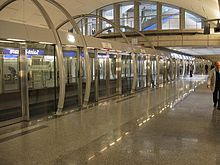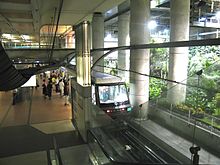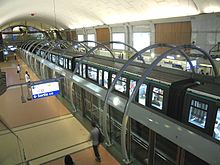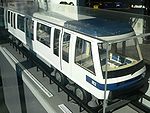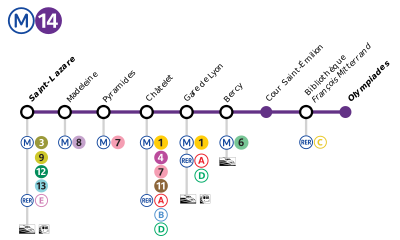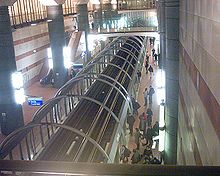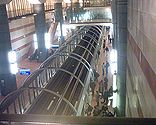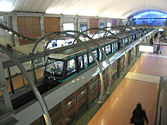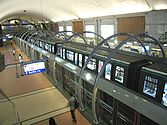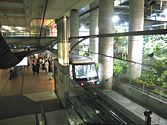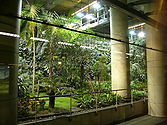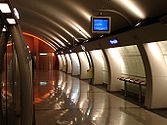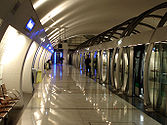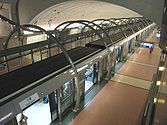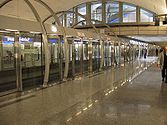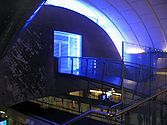- Paris Métro Line 14
-
Line 14 

Year opened 1998 Last extension 2007 Rolling stock MP 89 6 carriages per trainset
Stations served 9 Terminal stations Saint-Lazare
Length 9 km (5.6 mi) Average interstation 1129 m Journeys made 62,469,502 (per annum) Line 14 of the Parisian Métropolitian System connects the stations Saint Lazare and Olympiades on a north-west south-east diagonal across the centre of Paris. It is the twelfth busiest of sixteen lines on the network, and as of 2011, the only one to be operated completely automatically; the second such line in the Île-de-France after Orlyval. Before being put into commercial service it was known as project Météor, an acronym of MÉTro Est-Ouest Rapide.
The line is also occasionally used as a showcase for the savoir-faire of the RATP, its operator, and Systra and Siemens Transportation Systems, constructors of the rolling stock and automated equipment respectively when they bid internationally to build métro systems.
Contents
Chronology
- 15 October 1998: The new line 14 was inaugurated between Madeleine and Bibliothèque F. Mitterrand.
- 16 December 2003: Line 14 was extended north from Madeleine to Saint-Lazare.
- 26 June 2007: Line 14 was extended south from Bibliothèque François Mitterrand to Olympiades.[1]
Development
The Météor Project
The original line 14 linked Invalides with Porte de Vanves until 1976, when it was merged into the southern section of the current line 13.
Paris's east-west axis across has long been heavily travelled: Line 1 of the Métro began approaching saturation in the 1940s, necessitating the construction of Line A of the RER in the 1960s and '70s; which became the busiest urban routes in the world (by 2010 there were more than a million passengers each working day). To improve service, the SACEM (Système d'aide à la conduite, à l'exploitation et à la maintenance --"Assisted driving, control and maintenance system") was installed on the central run of Line A in September 1989. This improved efficiency and reduced the interval between trains to just two minutes, though an improvement ultimately insufficient to absorb the increasing demand. To cater permanently to demand on the busy artery between Gare Auber and Gare de Lyon new rail lines would have to be built.
Two proposals were made by the transport companies: the SNCF suggested a new tunnel between Châtelet and Gare de Lyon for Line D of the RER allowing traffic to circulate from the north and south-east of Île-de-France. More importantly it proposed "Project EOLE" ("Est-Ouest Liaison Express"), the creation of a new wide berth line, initially from Paris's eastern suburbs to Saint-Lazare, then an extension onwards to the western suburbs.
In 1987, the RATP proposed "project Météor", ("MÉTro-Est-Ouest-Rapide") the creation of a new Métro line, from Porte Maillot on the edge of the 16th arrondissement to the Maison Blanche district in the 13th, an area poorly served by transport despite its large population. The project would fit well with the regeneration of the Tolbiac district on the left bank around the new bibliothèque nationale de France, in that arrondisement.
The plans to go to Porte Maillot were eventually abandoned in favour of a terminus at Saint-Lazare, with the later possibility of extending the line to Clichy and assimilating the Asnières branch of Line 13, thus simplifying its complicated operation.
This new line parallel to Line A took the opportunity to incorporate innovations on the rest of the network: the stations are larger and, at 120 metres, longer and thus can accommodate eight carriages. The runs between stations are longer, allowing a rolling speed of close to 40 km per hour, close to double that of the other lines. Lastly, the line is completely automated and runs without any driver, the first major métropolitain line in a capital to do so.[N 1]
Given the pressing need, the council of Ministers of Michel Rocard's government approved the project in October 1989. However, budgetary constraints forced the reduction of both. In the first stage, EOLE would be but a simple extension of trains from the suburbs to the new underground station at Saint-Lazare and MÉTEOR limited to the central Madeleine - Bibliothèque run, thus leaving the main railway station of Saint-Lazare and the heart of the 13th arrondissement unserved.[N 2] The tunnels were dug between 1993 and 1995. It was opened to the public in 1998 and had its first automatic run in October 1998.
Some features of Line 14's train control system are run under the OpenVMS Operating System. Its control system is noted in the field of software engineering of critical systems because safety properties on some safety-critical parts of the systems were proved using the B-Method, a formal method. All trains on line 14 are completely automated. This means that there are no train engineers operating the train.
Line 14 has some unusual design features – its floor tiling is not bitumenised, and platform edge doors at stations prevent passengers from falling onto the track or from committing suicide.
The southern extension of the line to Olympiades in June 2007, an area of high rise towers in the XIIIe arrondissement that was not served very well, was not a real extension: the tunnel was built at the same time as the rest of the line, but it was used as a train maintenance area, so a new maintenance area was constructed. The building of this extension caused the collapse of the courtyard of an elementary school; fortunately, on that day, no children were present. For various reasons, the underground of much of Paris is quite fragile and considerable care must be exercised before tunnelling work. (See Catacombs of Paris.)
Construction begins
From November 1989 until the end of 1992 exploratory shafts and galleries were dug, tunnelling proper lasted from July 1993 until early 1995. In September 1993, Sandrine was baptised near la Bastille; a tunnel boring machine eighty metres long and eleven wide, she was capable of drilling a tunnel 8.6 metres across. Working twenty-four hours a day, five days a week, she bored twenty five metres below the water table. The terrain, made mostly of loosely packed limestone and marl was favourable to drilling and the tunnel advanced at a respectable 350 metres a month. The tunnel passes underneath seven Métro lines, the sewers, Clichy-Capucines, four underground carparks and over two RER lines.
Works initially hindered by a fifteen blockage from the bassin de l'Arsenal due to a flood of the Seine, the waterway having been chosen to minimise heavy traffic in the city. The tunnel reached the future station Pyramides on the 17 January 1995, and Madeleine on the 15 March; it stopped underneath boulevard Haussmann in August was brought above ground through shafts there the same month.[N 3]
At the other end of the line, from Gare de Lyon to Tolbiac the tunnel was excavated directly from the surface. It crossed the Seine upstream from pont de Tolbiac, supported by submerged beams the traditional under fluvial support. The last was implanted on 28 September 1994.
As a cost saving measure, the section from Gare de Lyon to the Basson de l'Arsenal was excavated at the same time as the tunnels of Line D of the RER Châtelet — Les Halles. The 816000m3 of debris excavated is about twice the volume of the Tour Montparnasse, Paris's largest building; and the 19000 tonnes of steel needed for re-inforced concrete and structural support is twice the mass of the Eiffel Tower.[2]
Extensions and incidents
Traffic on the line grew quickly: in October 2003, after five years in service there were 240 000 daily passengers.[3] The same year service was interrupted several times to allow the installation of material for an extension north from Madeleine to Saint-Lazare. This section was opened on the 16 December 2003, and the line saw a 30% increase in traffic thereafter; after Gare du Nord the northern terminus of Line 14 is the most important node on the network.
The southern extension, in June 2007, from Bibliothèque François-Mitterrand to Olympiades grew traffic again.[4] Initially planned for 2006, work was delayed by the collapse of the courtyard in the primary school at 11, rue Auguste-Perret during the night of 14-15 October 2006.[5] · [6]. Since then traffic has grown again: at the end of 2007, on average 450 000 passengers took the line on a working day.
Travellers have been largely satisfied with Line 14's speed and service. However, despite its automation it has not been free of accidents. While the platform doors prevent access to the rails, they are susceptible to electric outages which have halted service entirely. On the 20 September 2004, two trains stopped entirely in the tunnel after a signalling failure.[7] On the 22 December 2006, passengers were trapped for one and a half hours after an electrical failure on the line which arose from a mechinical failure.[8] Technological failures have occurred twice: on 21 March 2007 circulation was interrupted between Gare de Lyon and Bibliothèque François-Mitterrand;[9] and again on 21 August 2007 a technical failure stopped service.[10]
Impact
The experience in automated control and doors has inspired several new projects. In 1998, the RATP began planning to automate several lines, despite the heavy cost. The automation of Line 1 began in 2007, along with the introduction of doors on the platform.[11] The upgrade should be finished in 2012.[12]
The widespread introduction of platform doors for passenger safety is planned, despite the project's cost. In January 2004, ground level signalling to indicate the doorways was tested on Line 13 at Saint-Lazare station. Several different door models were tested during 2006 and Kaba was chosen to supply them. After testing, platform doors will be rolled out across the network, first in certain stations on Line 13, then on the totality of Line 1 in preparation for its complete automation.[S 1]
Technology
Signaling system
Météor as CBTC (Communication-based Train Control) system was supplied by Siemens Transportation Systems including monitoring from an operations control centre, equipment for 7 stations and equipment for 19 six-car trains, resulting in a headway of 85 seconds.[13]
It was the base for the Trainguard MT CBTC, which then equipped other rapid transit lines throughout the world.
Future
RATP have confirmed that line 14 will be extended north from Saint-Lazare, with the principal aim of reducing overcrowding on line 13.[14] The solution adopted crosses between the branches of line 13 with stations at Porte de Clichy on the Asnières – Gennevilliers branch and Mairie de Saint-Ouen on the Saint-Denis branch. The third confirmed additional station shall interconnect with the RER C station Saint-Ouen, while a decision is yet to be taken on whether a fourth stop, connecting the line 2 station Rome and Gare de Pont-Cardinet, will be added. Construction on the extension is scheduled to begin in 2013, with the aim of completion in 2017.[14]
Plans have also been mooted to extend the other end of the line eastwards from Olympiades to Maison Blanche, with a connection to Line 7's Villejuif branch possible.
The former line 14
The first line 14 was planned as line C of the Nord-Sud Company (line A being today's line 12 and line B being today's line 13). The Nord-Sud company went bankrupt in 1930 and was taken over by the other company operating Paris metro: the CMP (which later became the RATP). The CMP subsequently implemented Line C as line 14. In the 1970s, the line was incorporated into line 13.
Chronology
- 21 January 1937: line 14 was inaugurated between Bienvenüe and Porte de Vanves.
- 27 July 1937: The line was extended northbound from Bienvenüe to Duroc. The section between Invalides and Duroc which used to be served by line 10 was transferred to line 14.
- 9 November 1976: Line 14 was incorporated into line 13, which became a complete north-south line.
Stations renamed
- 6 October 1942: Bienvenüe was renamed as Montparnasse – Bienvenüe (today on line 13).
Route and stations
Routemap

Line 14 has interchanges with the five lines of the RER, and quickly links Saint-Lazare with Gare de Lyon, via Châtelet. The line begins underneath Saint-Lazare in a two way tunnel-head, after stopping in that station, it heads southwards, descending beneath buildings and winding around Line 12 and RER Line A. It bends eastward and passes underneath Line 12, before entering, straight on, the station Madeleine, situated on the northern corner of the eponymous church, underneath the narrow rue de Sèze. The tunnel quickly descends on a 40% slope underneath Line 8, itself nestled underneath the boulevards de la Madeleine and des Capucines, Line 14 continues at this depth underneath the buildings above. The 794 metre journey to the station Pyramides, finishes with a 45% climb to the station established just below l'avenue de l'Opéra.
List of stations
Station Connections observations Saint-Lazare Lines 3, 9, 12, 13
RER E
Transilien Saint-Lazare
Gare Saint-Lazare grande LineMadeleine Lines 8 and 12 near the Église de la Madeleine Pyramides Line 7 named after Battle of the Pyramids and actually matching with the glass pyramids built in the Cour du Louvre Châtelet Lines 1, 4, 7 and 11
RER A, B and Dnamed after Place du Châtelet Gare de Lyon Line 1
RER A and D
Transilien Lyon
Gare de Lyon (national rail)named after railway station to Lyon Bercy Line 6
Gare de Bercy (national rail)Cour Saint-Émilion Bibliothèque François Mitterrand RER C named after François Mitterrand Olympiades named after Les Olympiades Architecture
The conceptual design of the stations sought to evoke space and openness. The size of stations, their corridors and transfer halls brings the line architecturally closer to those of the RER rather than the existing Métro lines. The RATP opted for a specific style of the new line, for instance lightly coloured tiling rather than bitumen. The use of space was designed in a contemporary manner: voluminous spaces mixed plenty of light with modern materials and overall eased the flow of passengers. According to the designers, the stations should be the reflection of a "noble public space, monumental in spirit, urban in its choice of forms and materials". Four architects designed the first seven stations on the line: Jean-Pierre Vaysse & Bernard Kohn six of them, and Antoine Grumbach &t Pierre Schall the station Bibliothèque.[S 2]
Saint-Lazare benefits from a well of natural light visible on the keys, even though they are five levels below the surface. The station's exit is constructed from a glass bubble designed by Jean-Marie Charpentier and situated just in front of the Gare de Paris-Saint-Lazare, pointing towards the row of bus-stops.
Pyramides and Madeleine are endowed with a particular lighting, bright sunshine outside falls onto the platforms; a system which evidently does not work at night. Madeleine has several video projectors which allow cultural installations, for example, one on Marlène Dietrich, an actress, during the autumn of 2003.
Gare de Lyon offers travellers the view of a tropical garden on the right side of trains towards Olympiades, as one enters the station. This garden is situated underneath RATP House at the foot of which the station was built. It occupies a space originally reserved for the Transport Museum. Moreover, it is the only station equipped with a central platform, the only possible layout in light of the density of underground construction in the area.
Bibliothèque François-Mitterrand has its own unique design: monumental, fifteen metre pillars and stairs forming a semi-circle seventy metres in diameter.
The station Olympiades was developed by the architects "ar.thème associés" following the line's guiding principles, defined by Bernard Kohn from 1991. The station thus is in keeping with others in its choice of materials (polished concrete arches, wood on the ceilings, etc.) as much as in its lighting, height of its ceilings, and platforms larger than the average on other lines.
On the other hand, certain stations on the line are notable due to the disagreeable odour of humidity and sulfur that one can sometimes find as far as the changeover halls. Due to the line's relative depth, it runs underneath the water-table, creating a constant risk of seepage, similar to that found on Line E of the RER.[15]
Tourism
Metro line 14 passes near several places of interest:
- Two 19th-century train stations: Saint-Lazare and Gare de Lyon.
- The Church of the Madeleine.
- At Bercy, the Ministry of Finance, Paris-Bercy sports Arena and its gardens.
- Bercy village.
- The Bibliothèque nationale de France National Library of France and Paris' largest library.
Gallery
See also
Notes
References
- ^ "New section of Metro Line 14 opened". InfraSite.net. 2 July 2007. http://www.infrasite.nl/news/news_article.php?ID_nieuwsberichten=7579&language=en. Retrieved 6 July 2007.
- ^ Article (edit|talk|history|links|watch|logs)
- ^ Communiqué de presse RATP - La ligne 14 fête ses 5 ans !PDF Retrieved 5 October 2011. (French)
- ^ Le Parisien, Le métro compte une nouvelle station, article du 26 juin 2007
- ^ Conseil général des Ponts et Chaussées - Effondrement sur le chantier METEORPDF (824 KB), avril 2003
- ^ Journal l'Humanité - Une cour d'école s'effondre à Paris
- ^ MétroPole - La couleur pourpre www.metro-pole.net Retrieved 5 October 2011. {fr}}
- ^ MétroPole - Les pieds dans la prise... www.metro-pole.net Retrieved 5 October 2011. (French)
- ^ MétroPole - Coincé à faire un demi-tour www.metro-pole.net Retrieved 5 October 2011. (French)
- ^ La ligne 14 du métro victime d'une panne informatique www.cio-online.com Retrieved 5 October 2011. (French)
- ^ MétroPole - Kaba prend les portes www.metro-pole.net Retrieved 4 October 2011. (French)
- ^ Siemens Transportation Systems - Nos réalisations, Paris - ligne 1 Siemens website. Retrieved 4 October 2011(French)
- ^ "Driverless CBTC System for Line 14, Paris, France". Siemens AG. http://references.transportation.siemens.com/refdb/showReference.do?r=1432&div=2&l=en. Retrieved 9 July 2008.
- ^ a b "Prolongement de la ligne 14 de Saint-Lazare à Mairie de Saint-Ouen" (in French). RATP. http://www.ratp.fr/fr/ratp/c_11634/carte-d-identite/. Retrieved 17 November 2011.
- ^ MétroPole - Ce métro à l'odeur morose www.metro-pole.net (French)
External links
- (French) RATP official website
- (English) RATP english speaking website
- (English) Interactive Map of the RER (from RATP's website)
- (English) Interactive Map of the Paris métro (from RATP's website)
- (French) Mobidf website, dedicated to the RER (unofficial)
- (French) Metro-Pole website, dedicated to Paris public transports (unofficial)
- Paris Metro - Line 14 - St Lazare to Olympiades A passenger's video recording of a trip down the length of the line
Paris transport network  Métro
Métro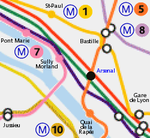
 RER
RER![[T]](/pictures/enwiki/49/16px-Logo_train_transilien.svg.png) TransilienNord
TransilienNord


![[H]](/pictures/enwiki/49/16px-Logo_Paris_Transilien_ligneH.svg.png)
![[K]](/pictures/enwiki/49/16px-Logo_Paris_Transilien_ligneK.svg.png) • Saint-Lazare
• Saint-Lazare 
![[J]](/pictures/enwiki/49/16px-Logo_Paris_Transilien_ligneJ.svg.png)
![[L]](/pictures/enwiki/49/16px-Logo_Paris_Transilien_ligneL.svg.png)
![[U]](/pictures/enwiki/49/16px-Logo_Paris_Transilien_ligneU.svg.png) • Lyon
• Lyon 
![[R]](/pictures/enwiki/49/16px-Logo_Paris_Transilien_ligneR.svg.png) • Montparnasse
• Montparnasse 
![[N]](/pictures/enwiki/49/16px-Logo_Paris_Transilien_ligneN.svg.png) • Est
• Est 
![[P]](/pictures/enwiki/49/16px-Logo_Paris_Transilien_ligneP.svg.png)

 Tramway
Tramway Bus
Bus Other
Other ProjectArc Express · Grand Paris · CDG Express · Tangentielle Nord · Grande ceinture Ouest · Tram-train Évry - Massy
ProjectArc Express · Grand Paris · CDG Express · Tangentielle Nord · Grande ceinture Ouest · Tram-train Évry - Massy Admin and Finance
Admin and FinanceParis Métro Line 14 Saint-Lazare





 · Madeleine
· Madeleine 

 · Pyramides
· Pyramides 
 · Châtelet
· Châtelet 







 · Gare de Lyon
· Gare de Lyon 



 · Bercy
· Bercy 
 · Cour Saint-Émilion · Bibliothèque François Mitterrand
· Cour Saint-Émilion · Bibliothèque François Mitterrand 
 · OlympiadesCategories:
· OlympiadesCategories:- Paris Métro line 14
- Siemens Transportation Systems projects
- Railway lines opened in 1998
Wikimedia Foundation. 2010.

